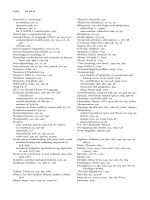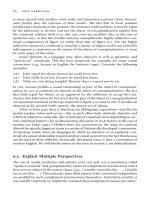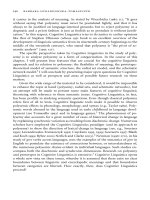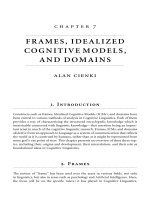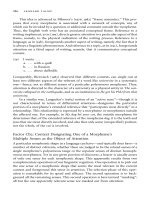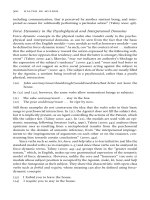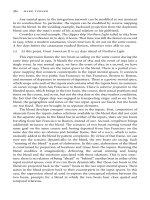The Oxford Handbook of Cognitive Linguistics Part 21 doc
Bạn đang xem bản rút gọn của tài liệu. Xem và tải ngay bản đầy đủ của tài liệu tại đây (171.1 KB, 10 trang )
chapter 7
FRAMES, IDEALIZED
COGNITIVE MODELS,
AND DOMAINS
alan cienki
1. Introduction
Constructs such as frames, Idealized Cognitive Models (ICMs), and domains have
been central to various methods of analysis in Cognitive Linguistics. Each of them
provides a way of characterizing the structured encyclopedic knowledge which is
inextricably connected with linguistic knowledge—that assertion being an impor-
tant tenet in much of the cognitive linguistic research. Frames, ICMs, and domains
all derive from an approach to language as a system of communication that reflects
the world as it is construed by humans, rather than as it might be represented from
some god’s-eye point of view. This chapter presents an overview of these three top-
ics, including their origins and development, their interrelation, and their role as
foundational ideas in Cognitive Linguistics.
2. Frames
The notion of ‘‘frame’’ has been used over the years in various fields, not only
in linguistics, but also in areas such as psychology and Artificial Intelligence. Here,
the focus will be on the specific role(s) it has played in Cognitive Linguistics,
where Charles J. Fillmore’s work has been particularly influential. As explained in
the following overview, Fillmore began using the term solely on the level of lin-
guistic description, and later, he and others extended its use to include charac-
terization of knowledge structures, thus linking the analysis of language to the study
of cognitive phenomena.
In his papers ‘‘Frame semantics’’ (1982a) and ‘‘A private history of the concept
‘Frame’ ’’ (1987), Fillmore reveals the influences which led to his formulation and
development of the notion. In the 1950s, he was exploring the principles behind the
co-occurrence of strings of words, influenced by Fries (1952), and later by Pike’s
(1967) work on ‘‘tagmemic formulas.’’ Fillmore’s early work on transformational
syntax led him into researching the distributional properties of individual verbs
(e.g., Fillmore 1961). This research involved looking at the substitutability of words,
within what could be called syntactic frames, while preserving the meaning of the
utterance. But soon the use of ‘‘frame’’ extended from syntax to semantics. Fillmore
(1982a: 114) reflects that by the late 1960s, ‘‘I began to believe that certain kinds of
groupings of verbs and classifications of clause types could be stated more mean-
ingfully if the structures with which verbs were initially associated were described
in terms of the semantic roles of their associated arguments.’’ Trying to adapt
Transformational Generative Grammar to this way of thinking, he proposed deep-
structure valence descriptions for verbs. These ‘‘case frames’’ (Fillmore 1968) spec-
ified the semantic roles of the nominals which could occur with a given verb.
However, even ‘‘this theory of semantic roles fell short of providing the detail
needed for semantic description; it came more and more to seem that another in-
dependent level of role structure was needed for the semantic description of verbs
in particular limited domains’’ (Fillmore 1982a: 115). He adds that rather than
developing an account in terms of truth conditions, which was customary at the
time, ‘‘it seemed to me more profitable to believe that there are larger cognitive
structures capable of providing a new layer of semantic rule notions.’’
His first attempt at describing such a cognitive structure appeared in his 1971
paper on ‘‘verbs of judging.’’ Here he makes the claim that verbs such as blame, ac-
cuse,andcriticize highlight a person who forms a judgment on the worth or behavior
of some situation or individual (which he calls ‘‘the Judge’’), a person whose behavior
is being judged (‘‘the Defendant’’), and some situation in which judgment seemed
relevant (‘‘the Situation’’). So use of the verb accuse asserts that the Judge, presup-
posing the badness of the Situation, claimed that the Defendant was responsible.
However, with the verb criticize, one asserts that the Judge, presupposing the De-
fendant’s responsibility for the Situation, presented arguments for believing that the
Situation was in some way blameworthy, and so forth. Note how this differs from the
earlier idea of a case frame in that ‘‘we have here not just a group of individual words,
but a ‘domain’ of vocabulary whose elements somehow presuppose a schematiza-
tion of human judgment and behavior involving notions of worth, responsibility,
judgment, etc.’’ (Fillmore 1982a: 116). This draws on the speaker’s/addressee’s back-
ground knowledge about what would likely be relevant in such a Situation, or as he
came to call it in a more generic sense, the relevant ‘‘scene.’’
frames, idealized cognitive models, and domains 171
In response to the dominant semantic theories in American linguistics in the
1970s, in which linguists tried to capture word meanings in terms of sets of nec-
essary and sufficient conditions, Fillmore proposed ‘‘an alternative to checklist
theories of meaning’’ (Fillmore 1975). Here he presented a ‘‘scenes-and-frames par-
adigm.’’ Fillmore notes, ‘‘I use the word scene in a maximally general sense, in-
cluding not only visual scenes but also familiar kinds of interpersonal transactions,
standard scenarios defined by the culture, institutional structures, enactive expe-
riences, body image’’ (1975: 124)—in short, what in some ways will be captured in
later years by the term domain. He continues, ‘‘I use the word frame for any system
of linguistic choices—the easiest cases being collections of words, but also including
choices of grammatical rules or linguistic categories—that can get associated with
prototypical instances of scenes.’’ Though frames are talked about from a linguistic
viewpoint, it is noteworthy that they are not presented as an independent approach
to linguistic analysis, but rather as one part of a paradigm, integrally linked to the
idea of scenes.
The connection made between frames and scenes is made even clearer with
his examples in that paper, such as the following. The English word write and the
Japanese word kaku are commonly considered translation equivalents, but since the
overall scenes associated with the words in their respective cultures differ, the lin-
guistic frames within which each word is used also differ coordinately. The scene
associated with the English word entails that it is some form of language that is
written, while the scene linked to the Japanese word is less specific and could in-
clude various kinds of drawing. Thus, the frame for answering the question ‘‘What
did you write?’’ would be limited to expressions for ‘‘a linguistic communication
scene,’’ while in Japanese the frame for answering the coordinate question about
kaku affords a broader range of possibilities.
In the analysis of the ‘‘commercial event,’’ Fillmore (1977) shows that a large set
of English verbs are related to each other by how they evoke the same general scene
in different ways. Verbs such as buy, sell, spend, and cost entail an understanding of
the relevant roles (buyer, seller) and elements (goods, money) in terms of which
the actions of buying, selling, spending, and costing are construed. The argument
made is that with verbs of judging, verbs of commercial transaction, and many
others, ‘‘nobody can really understand the meanings of the words in that domain
who does not understand the social institutions or the structures of experience
which they presuppose’’ (Fillmore 1987: 31).
1
In his 1985 paper, Fillmore makes a distinction between theories concerned
with the semantics of truth (T-semantics) and those based on language under-
standing (U-semantics) and concludes that ‘‘both the notion of truth and the uses
of negation needed for a formal T-semantics are secondary to the understanding
of those notions that arise from a study of U-semantics’’ (223). In contrast to the
dictionary-like notion of meaning inherent in (particularly American) formalist
approaches to semantics in the 1970s, the theory of linguistic frames embraces an
encyclopedic view of meaning (223), which continues in Cognitive Linguistics to
this day. The work on frames also developed in opposition to purely compositional
172 alan cienki
approaches to semantics, according to which the meaning of a text is simply deter-
mined by the integration of the meanings of its component words and sentences.
Fillmore (1986: 52) points out, ‘‘While the task of linguistic semantics must be to
explain how text meanings are developed, the knowledge which is called on for
achieving this task is not limited to linguistic knowledge.’’
Fillmore’s work was thus integrally connected with other advances in Cog-
nitive Linguistics as the field developed. He was influenced by the ongoing research
on prototypes (e.g., citing Rosch 1973), and in his 1975 paper, Fillmore makes a bid
for linking research on frames and prototypes, since ‘‘in some cases the area of ex-
perience on which a linguistic frame imposes order is a prototype’’ (123). He notes
in his 1982a paper that often the frame against which a word is understood involves
a schematized prototype of what some part of the world is like. He uses the word
orphan as an example. We can say the word refers to a child whose parents are no
longer living, but ‘‘the category ORPHAN does not have ‘built into it’ any speci-
fication of the age after which it is no longer relevant to speak of somebody as an
orphan, because that understanding is a part of the background prototype’’ (118).
This idea of frames as drawing on background prototypes sounds like what Lakoff
will later call Idealized Cognitive Models, and in 1985, Fillmore makes an explicit
comparison between his notion of scene and constructs (223), such as Lakoff’s (1982)
cognitive model, Lakoff and Johnson’s (1980) experiential gestalt, and Langacker’s
(1984) base (in contrast to profile).
Influenced by work in the 1970s on pragmatics and speech acts, Fillmore also
claimed that we not only employ cognitive frames to produce and understand lan-
guage, but also to conceptualize what is going on between the speaker and addressee,
or writer and reader. This introduced the idea of framing on another level, in terms
of ‘‘interactional frames.’’ Such interactional frames provide a tool for talking about
the background knowledge and expectations one brings to bear for the production,
and interpretation, of oral or written discourse, particularly in relation to accepted
genre types. Knowing that a text is a business contract, a folktale, or marriage pro-
posal, one employs specific structures of expectations which help lead to a full inter-
pretation of the meaning, and also help one know when the text is ending, and how
to respond, if that is appropriate (Fillmore 1982a: 117).
Though the notion of frames developed in cognitive psychology independently
in the 1970s (Fillmore 1987), Fillmore (1975: 124 and elsewhere) acknowledges con-
nections between his use of the term and earlier uses by others. Andor (1985) pro-
vides an overview of the use of frame and related terms in linguistics, psychology,
and computer science. Tannen (1985: 327) comments on use of the notion of frames
in anthropology and sociology, a
`
la Bateson (1972) and Goffman (1974), and notes
that there it may be better understood as ‘‘frames of interpretation’’ (see also
Tannen 1993). However, the common thrust behind these different framings of the
term ‘‘frame,’’ namely that knowledge schemas guide and structure our use of lan-
guage, is of greater significance than the distinctions between the various uses of the
term in different disciplines. In later work, Fillmore (1986: 49) admits having given
up on maintaining a differentiation between the terms frame, schema, scene, script
frames, idealized cognitive models, and domains 173
(a standard event sequence found in a specific context, as described by Schank and
Abelson 1977), and so on. Rather, all of these reflect different levels of frame
knowledge. The idea that language has a frame-like structure as a natural reflection
of the ways in which we frame knowledge led to the ‘‘frame-semantic treatment of
various classes of grammatical constructions’’ (Fillmore 1986: 55)—which became
known as Construction Grammar (Goldberg 1995). Hudson (1985, 1986) concurs
that, unless proven to the contrary, a viable working assumption is that linguistic
structure works the same way as nonlinguistic conceptual structure, and he pro-
poses his Word Grammar (Hudson 1984) as an integrative theory which embraces
this position. For similar reasons, Langacker (1987, 1991),drewon frame semantics in
the development of Cognitive Grammar. (See chapters 17, 18, and 19 of the present
Handbook on each of these theories of grammar.)
As frame semantics developed in the 1970s and early 1980s, it perhaps had more
influence as a theoretical construct, and as a stimulus to think about semantics in
a different way, than it had as an analytic tool in empirical research (O
˜
im and
Saluveer 1985: 295). However, if the MLA International Bibliography is an accurate
indication, more studies have been published since the late 1980s to the present
which use a frame approach in research in specific areas of lexical semantics, par-
ticularly in cross-linguistic research (see, for example, Petruck 1995; Rojo Lu
´
pez and
Valenzuela 1998; and Croft, Taoka, and Wood 2001). Frame semantics portends later
research on first-language acquisition, such as approaches to grammar as templates,
and Tomasello’s (1992) ‘‘Verb Island hypothesis.’’ It also has implications for re-
search in historical linguistics. Often a change in linguistic label for something is a
consequence of a change in the linguistic frame in which it plays a part. A case in
point is ‘‘World War I, which was not called World War I until there was a World
War II to get the counting frame started’’ (Fillmore 1985: 239).
Finally, framing has found important application in recent years with in-
creasing awareness of the persuasive effects that can be achieved by reframing, or
using alternative framings, of an issue. ‘‘From a frame semantics point of view, it is
frequently possible to show that the same ‘facts’ can be presented within different
framings, framings which make them out as different ‘facts’ ’’ (Fillmore 1982a: 125).
We also see use of the word frame in Reddy ([1979] 1993) and Scho
¨
n([1979] 1993)to
refer to ways of thinking about an issue which are reflected in the use of meta-
phorical language. The manner in which one frames an issue can have practical
implications for social policy and for politics. Witness Scho
¨
n’s point that different
solutions may seem more logical when one calls a low-income neighborhood a dis-
eased area versus when one considers it to be a natural community; in the former case
the neighborhood should be removed, whereas in the latter it should be nurtured and
developed. (See also the papers in Dirven, Frank, and Ilie 2001 for analyses of ide-
ologies in discourse in terms of frames and models.) Framing is now being used
explicitly as an analytic tool by organizations such as the FrameWorks Institute
(Washington, DC), which strives to advance the nonprofit sector’s communications
capacity through research on framing public discourse about social problems, and
174 alan cienki
the Rockridge Institute (Berkeley, CA), which endorses reframing public debate in
the United States in support of progressive politics.
3. Idealized Cognitive Models
The notion of Idealized Cognitive Models was preceded by a theoretical explora-
tion of the application of Gestalts in linguistics, namely in a new approach dubbed
‘‘experiential linguistics.’’ The basic claim of experiential linguistics, as Lakoff (1977:
237) proposes, is that ‘‘a wide variety of experiential factors—perception, reasoning,
the nature of the body, the emotions, memory, social structure, sensorimotor and
cognitive development, etc.—determine in large measure, if not totally, universal
structural characteristics of language.’’ This way of thinking sets the stage for many
later developments, which come to be known collectively as Cognitive Linguistics.
Lakoff continues: ‘‘What I would ultimately like to show (or see other people show)
is that thought, perception, the emotions, cognitive processing, motor activity, and
language are all organized in terms of the same kinds of structures, which I am
calling gestalts’’ (246).
He notes that while his use of the term bears some relation to the concept
developed by the Gestalt psychologists, it is not intended to refer to exactly the same
thing. The following are some of the many properties which Lakoff (1977: 246–47)
ascribes to Gestalts:
Gestalts are structures that are used in cognitive processing;
Gestalts are wholes whose component parts take on additional signifi-
cance by virtue of being within those wholes;
Gestalts have internal relations among parts, which may be of different types;
Gestalts may have external relations to other Gestalts;
there may be partial mappings of one Gestalt onto another, or embedding
of one within another;
a Gestalt analysis need not necessarily make claims about the ultimate parts
into which something can be decomposed, since such analysis would be
guided by cognitive purposes and viewpoints, and thus different analyses
may be possible; but
Gestalts must distinguish prototypical from nonprototypical properties; and
Gestalts are often cross-modal.
Instantiations of Gestalts in language may involve a number of types of properties,
such as grammatical, pragmatic, semantic, and/or phonological ones.
All of this comprises an alternative to the formal syntactic rules of Trans-
formational Generative Grammar, which essentially try to handle grammar in a
frames, idealized cognitive models, and domains 175
mathematical framework. Instead, the characterization of linguistic Gestalts stems
from what is (or was in the 1970s) being discovered about general processes of cog-
nition, and of categorization in particular. The Gestalt approach supports the view
that grammar does not rely on absolute rules, but rather involves flexible patterns
and notions like partial similarity, or partial mapping to a pattern.
The phenomenon of ‘‘Patient subjects’’ provides a case in point. Lakoff (1977:
248–54)andvanOosten(1977) discuss how in certain sentences, the usual object of a
transitive verb (the Patient) can be used as a subject with an active verb, as in This car
drives easily or Bean curd digests easily. But this is not possible with all verbs, and
thus sentences like *Bean curd eats easily are semantically strange (as indicated by the
asterisk). They claim that the grammatical property of subjecthood prototypically
pairs with the semantic properties of ‘primary responsibility’, ‘control’, and ‘volition’,
as one typically finds in Agent-subject sentences. In Patient-subject sentences, one
finds that the properties of the Patient are more responsible for what happens than
those of the Agent. So ‘primary responsibility’ is the most important property paired
with subjecthood, to the extent that it can have priority even if ‘control’ and ‘volition’
are not involved (i.e., cars and beans do not have independent control or volition).
Another factor that is relevant in the formulation of such sentences is which prop-
erties of the Agent or the Patient the speaker is putting into focus. Regarding the verbs
digest and eat, properties of the Patient can be primarily responsible for whether
digestion takes place, but not for whether eating takes place. So the sentence *Bean
curd eats ea sily is infelicitous because of the conflict inherent between Patient focus
(with the subject bean curd)andAgentfocus(withtheverbeats). In this way, lin-
guistic Gestalts involve perspective (in terms of Agent- or Patient-focus)—another
way in which the theory is based on factors of human (cognitive and embodied)
experience. The linguistic Gestalts of the special-purpose Patient-subject sentences,
described above, and the more common type of sentences (in which the Patient is the
object of the verb), also bear partial similarity to further types of sentence construc-
tions, such as those with reflexive-Patient-subjects (e.g., Those dresses practically sell
themselves). In sum, the syntax of a language is structured by numerous overlapp-
ing Gestalts, the knowledge of which guides speakers (or writers, or signers) in their
production of language and guides addressees in their comprehension.
This notion of Gestalts provided the underpinnings for the development of Ide-
alized Cognitive Models (ICMs) in Cognitive Linguistics. The first detailed expli-
cation of ICMs appeared in Lakoff (1987), as part of a synthesis of existing research
on categorization within the various branches of cognitive science. ICMs are pro-
posed as a way in which we organize knowledge, not as a direct reflection of an
objective state of affairs in the world, but according to certain cognitive structuring
principles. The models are idealized, in that they involve an abstraction, through
perceptual and conceptual processes, from the complexities of the physical world.
At the same time, these processes impart organizing structure—for example, in the
form of conceptual categories. The use of models in cognitive processing that are
idealized in the ways described below also makes sense from an evolutionary per-
spective. They provide an advantageous means of processing information because
176 alan cienki
they are adapted to human neurobiology, human embodied experience, human ac-
tions and goals, and human social interaction.
An example which Lakoff uses helps illustrate the concept of ICMs. The En-
glish word bachelor has provided semantic fodder for linguists for decades. At least
in American English, it has largely been replaced by the gender-neutral single,but
many aspects of the analysis below carry over to the word single as well. Katz and
Postal’s (1964) analysis of the semantics of bachelor led to its frequent citation as an
example of the successful transferal of markedness theory from phonology to seman-
tics (using [human], [male], [adult], and [never married] as semantic features).
However, Fillmore (1982b) points out that the word and the analysis of it in terms of
necessary and sufficient conditions assumes a certain frame of background knowl-
edge, including expectations about marriage and requirements of eligibility for it.
Fillmore (1982b: 34) observes, ‘‘male participants in modern long-term unmarried
couplings would not ordinarily be described as bachelors’’ and ‘‘[Pope] John Paul II
is not properly thought of as a bachelor.’’ Lakoff (1987) highlights the point that
this word is defined with respect to a model of the world in which certain expecta-
tions hold (such as opposite-sex partnership, typical marriageable age, etc.), and this
model is idealized in that it ignores many possible aspects of the real world (same-sex
partnerships, a role in a religious institution which requires a vow of chastity, etc.).
Thus, bachelor (and in many of the same ways, the word single as used in parallel
contexts) is defined with respect to an ICM. It is worth noting that currently the word
is used far less frequently on its own and usually occurs in a few conventionalized
collocations, such as eligible bachelor or bachelor party (for the groom-to-be on the
eve of his wedding). Yet, these set collocations in which the word remains in use today
also highlight specific elements of that ICM. So eligible bachelor makes the eligibility
requirement salient, and a bachelor party accentuates the licentious behavior that is
part of a stereotype of a man’s life before marital responsibilities.
The example above shows only some aspects of what can constitute an ICM.
Lakoff (1987: 284) enumerates the following as five basic types of ICMs: proposi-
tional, image-schematic, metaphorical, metonymic, and symbolic. Let us consider
each in turn in more detail.
3.1. Propositional ICMs
Lakoff (1987: 284–87) describes propositional models as having to do with entities,
their properties, and the relations between the entities. What differs here from the
objectivist assumptions of semantic theory based in symbolic logic is that prop-
ositional models are not claimed to correspond directly to slices of reality. Rather,
as cognitive models, the entities and the relations between them are mental con-
structs. Lakoff, furthermore, points out that the propositional structure of ICMs
may be of various types, among them: the simple proposition, the scenario (or
script), the feature bundle, the taxonomy, or the radial category. He describes each
of these in the following way.
frames, idealized cognitive models, and domains 177
A simple proposition consists of arguments and a predicate, and more complex
examples involve operations known from logical theory, such as quantification,
conjunction, negation, and so on. A propositional ICM structured according to a
scenario will be about an initial state, a sequence of events, and a final state. Typically,
scenarios concern the states and activities of people; thus, the events are structured
by the motivation of their purposes. We can think of Schank and Abelson’s (1977)
‘‘restaurant script’’ as a scenario-based ICM. This script specified the specific knowl-
edge of the events which typically take place when one visits a restaurant and the
objects and events playing a role in these restaurant events, all of which were char-
acterized in a form appropriate for a computer program. In this way, we can see
connections between Artificial Intelligence research and theories of cognitive mod-
els, as well as the continuing influential role of Fillmore’s frame semantics.
If a feature bundle is a collection of properties, then a propositional ICM
structured in this way can be seen as what has been called a ‘‘classical category,’’
that is, a category with clear boundaries defined by the properties common to all of
its members. This is the folk model of how categories work, which is often em-
ployed in everyday reasoning without our realizing it. ‘‘Categorical statements,’’
which make uniform claims about all members of a category, represent this type of
reasoning.
Taxonomic propositional ICMs consist of hierarchically structured classical
categories. A higher-order category is a whole, and the immediately lower categories
are the parts of which it is composed, with no overlap of the categories at each level.
Since a classical category is structured by a feature bundle ICM, higher-level cate-
gories must include all the features of their lower-level parts. Taxonomies of natural
things—such as plants, animals, or minerals—represent this kind of categorization
(see also Schmid, this volume, chapter 5).
A radially structured propositional ICM describes a category with its subcat-
egories structured as containers within it. But this type of model is distinctive in
that one subcategory is the center, and the other subcategories are connected to it
by various kinds of links. The result is a center-periphery structure. Noncentral
subcategories can be subcenters in that they may have other subcategories linked to
them, in a smaller center-periphery structure. This approach has been applied in
semantic analyses of many lexical items, morphemes, and grammatical construc-
tions (see Lewandowska-Tomaszczyk, this volume, chapter 6). With the radially
structured ICM, we already begin to go beyond the scope of the propositional
ICMs in that the links between subcategories often involve metaphor or meton-
ymy, whereas the other types of propositional ICMs use these devices less if at all.
3.2. Image schemas and ICMs
Johnson (1987: xiv) characterizes an image schema as ‘‘a recurring, dynamic pattern
of our perceptual interactions and motor programs that gives coherence and
structure to our experience’’; he elaborates on approximately thirty image schemas
178 alan cienki
which he considers to be the most important ones (see Oakley, this volume, chapter
9, for details). Drawing on this work, Lakoff (1987) demonstrates the structuring
role which image schemas play in various types of ICMs.
2
One set of examples is the
propositional ICMs, discussed above: a simple proposition is structured according
to a part-whole schema in terms of the relation of the predicate to the propo-
sition, of which it is a part; a scenario-based propositional ICM is structured by a
path schema in the domain of time, normally with a ‘‘source’’ (an initial state) and
a ‘‘goal’’ (a final state); and a radially structured propositional ICM is characterized
by a center-periphery schema.
Lakoff implies that image schemas themselves can be the major structuring
elements of certain ICMs by virtue of the fact that each represents a simplified (ide-
alized) abstraction of some pattern in our bodily experience which we use as a
model for conceptualizing other (more abstract) aspects of our lives. But even such
models necessarily employ metaphorical mappings to link the image schemas to
relevant target domains. So the container image schema, with its structural ele-
ments of ‘interior’, ‘boundary’, and ‘exterior’, provides a model for conceptualizing
basic logic, such as the Boolean logic of classes. We understand not only classical
categories, but also states of being and many other abstract entities as ‘‘containers’’
via metaphorical extensions from the image schema. Other image schemas serve as
the basis for other cognitive models via metaphorical and metonymic extensions, as
Johnson (1987) discusses in detail.
3.3. Metaphor and ICMs
Conceptual metaphors (see Grady, this volume, chapter 8) are usually cited for the
structuring role they can play in ICMs, rather than being claimed to constitute
ICMs in and of themselves. Thus, in one case study, Lakoff (1987) shows the im-
portant structuring role that metaphor plays in our ICM of ‘anger’. But other
structuring principles are also at work, such as prototypical scenarios in which
anger can arise. As Emanatian (1999) points out, the degree to which metaphor can
play a role in a model can differ vastly depending on the domain in question, from
little or none (as in the American schema of what one does when going to a laun-
dromat) to essentially exhausting a model (as in our ways of understanding and
describing an abstract domain like ‘thought’ itself, which is difficult to do without
metaphors).
3.4. Metonymy and ICMs
Lakoff (1987: 78) uses the term metonymic model to refer to an ICM which contains
relation(s) in which one thing stands for another. As an example, Lakoff and John-
son (1980, chapter 8) discuss how we make sense out of sentences like The White
House isn’t saying anything by invoking the common metonymy whereby a place
frames, idealized cognitive models, and domains 179
